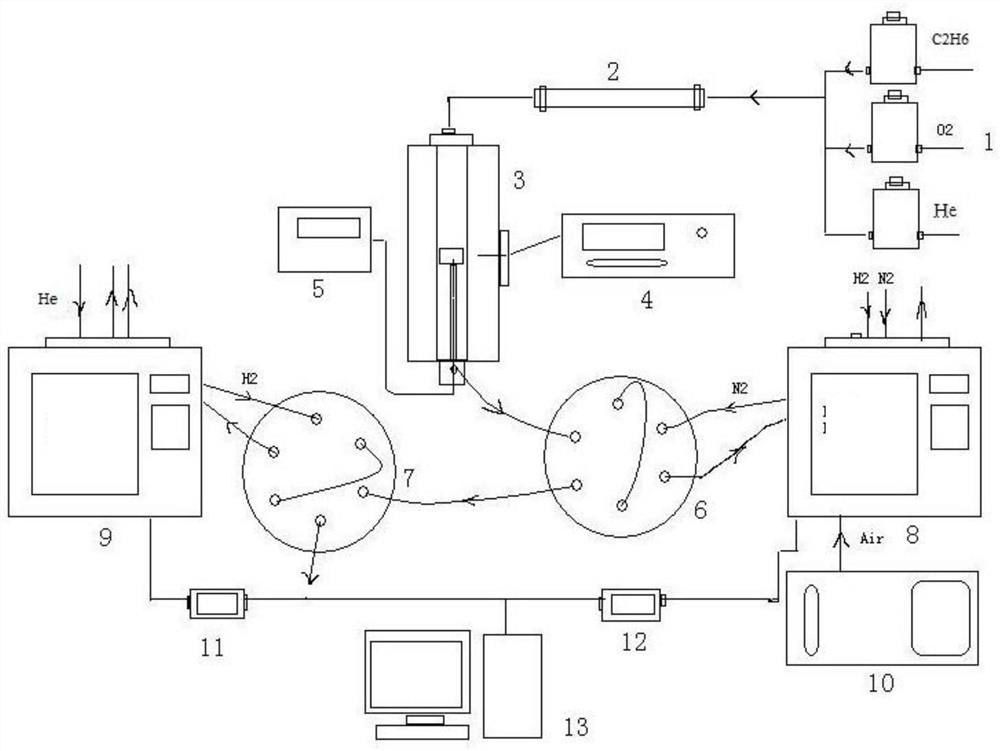Propane dehydrogenation method catalyzed by transition metal oxide-silica molecular sieve catalyst
A technology for catalysts to catalyze propane and transition metals, applied in the field of propane dehydrogenation, can solve the problems of complex moving bed technology, expensive equipment investment, easy carbon deposition and deactivation, etc., achieve energy saving, emission reduction, production safety risks, reduce production safety risks, Solve the serious effect of carbon deposition
- Summary
- Abstract
- Description
- Claims
- Application Information
AI Technical Summary
Problems solved by technology
Method used
Image
Examples
Embodiment 1
[0027] Example 1: Application of MFI type Na / VS-1 molecular sieve catalyst in propane dehydrogenation
[0028]The MFI-type framework-doped VS-1 catalyst is synthesized by a hydrothermal method. The synthesis method refers to the literature published by the inventor's team (Journal of the American Chemical Society 2020 142(38), 16429-16436). The specific synthesis steps are as follows: 0.5 g of ammonium metavanadate (NH 4 VO 3 ) was dissolved in 10 ml of deionized water, stirred for 10 min and then added 1.0 g of oxalic acid, and continued to stir for 20 min until fully dissolved to obtain a V-oxalic acid solution. Another 6.60 g of TPAOH (aqueous tetrapropylammonium hydroxide, 40% wt) and 6.93 g of TEOS (tetraethyl silicate) were added sequentially to 16.9 ml of deionized water. After stirring for 0.5h, 2.89g of the aforementioned V-oxalic acid solution was added dropwise, and finally stirred for 8h. The final solution was transferred to a stainless steel reactor lined with...
Embodiment 2
[0037] Example 2: Application of MFI type K / MoS-1 molecular sieve catalyst in propane dehydrogenation
[0038] The MFI-type framework Mo-doped K / MoS-1 catalyst was synthesized by a hydrothermal method, similar to Example 1, and the specific synthesis steps were as follows: 0.5 g of ammonium molybdate ((NH 4 ) 6 Mo 7 O 24 ·4H 2 O) was dissolved in 10 ml of deionized water, and stirred for 10 min to obtain an ammonium molybdate solution. Another 6.60 g of TPAOH (aqueous tetrapropylammonium hydroxide, 40% wt) and 6.93 g of TEOS (tetraethyl silicate) were added sequentially to 16.9 ml of deionized water. After stirring for 0.5h, 2.89g of the aforementioned ammonium molybdate solution was added dropwise, and finally stirred for 8h. The subsequent hydrothermal crystallization and post-treatment methods are the same as those in Example 1, and the final product obtained is MFI-type framework-doped MoS-1. 2g MoS-1 was placed in 50ml 0.5M potassium nitrate solution and stirred at ...
Embodiment 3
[0041] Example 3: Application of MFI type Mg / CrS-1 catalyst in propane dehydrogenation:
[0042] The MFI-type framework Cr-doped CrS-1 catalyst was synthesized by a hydrothermal method, similar to Example 1, and the specific synthesis steps were as follows: 1.0 g of chromium nitrate nonahydrate was dissolved in 10 ml of deionized water to obtain a solution. Another 6.60 g of TPAOH (aqueous tetrapropylammonium hydroxide, 40% wt) and 6.93 g of TEOS (tetraethyl silicate) were added sequentially to 16.9 ml of deionized water. After stirring for 0.5h, 2.89g of the aforementioned chromium nitrate solution was added dropwise, and finally stirred for 8h. The subsequent hydrothermal crystallization and post-treatment methods are the same as those in Example 1, and the final product obtained is MFI-type skeleton-doped CrS-1. 2g of CrS-1 was placed in 50ml of 0.2M magnesium nitrate solution and stirred at 60°C for 2h, filtered, dried, and calcined at 550°C for 2h in a muffle furnace. Th...
PUM
 Login to View More
Login to View More Abstract
Description
Claims
Application Information
 Login to View More
Login to View More - R&D
- Intellectual Property
- Life Sciences
- Materials
- Tech Scout
- Unparalleled Data Quality
- Higher Quality Content
- 60% Fewer Hallucinations
Browse by: Latest US Patents, China's latest patents, Technical Efficacy Thesaurus, Application Domain, Technology Topic, Popular Technical Reports.
© 2025 PatSnap. All rights reserved.Legal|Privacy policy|Modern Slavery Act Transparency Statement|Sitemap|About US| Contact US: help@patsnap.com



